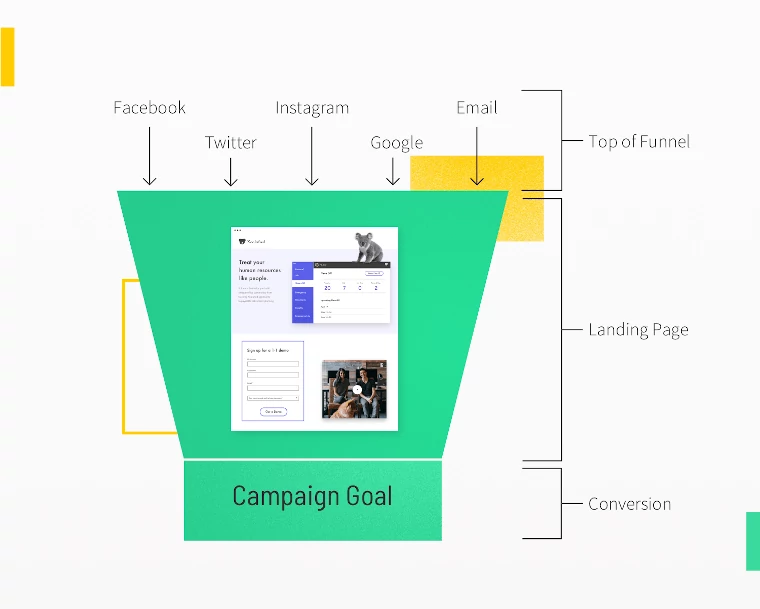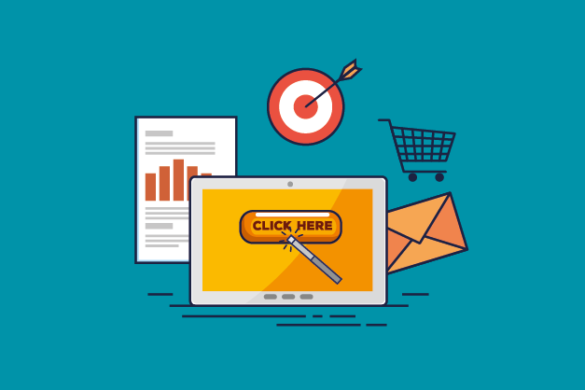Table of Contents
A landing page is a standalone page specifically designed to capture leads or conversions. You arrive on a landing page after clicking a link in an ad.
What does a landing page on a website actually consist of? You’ve come to the correct place if this is on your mind!
Getting users to become leads and then convert is the main goal when it comes to online marketing. The ultimate goal is always the same, even though the particular strategies used may differ—from social media marketing to pay-per-click (PPC) advertising and search engine optimization (SEO).
The development of landing pages is key to many digital marketing tactics in order to generate leads and conversions.
We’ll go beyond the definition of a landing page in the discussion that follows. So tune in as we continue our exploration!
What is a landing page?
A landing page is a stand-alone website designed to generate leads or conversions. After clicking on an advertisement link, you are taken to a landing page. You see a call to action (CTA) when you first arrive, urging you to buy something or register for something.
Landing page vs. homepage: What’s the difference?
Now that you know what a landing page on a website is, let’s look at how it differs from a homepage.
Before you start creating your own landing pages, it’s important to understand the difference between a landing page and a homepage.
- A landing page is a stand-alone webpage that serves as a conduit for a targeted audience via online advertising, newsletters, and targeted calls-to-action. Converting users into clients or subscribers is its main goal.
- A homepage, on the other hand, acts as your company’s storefront, showcasing your value proposition to customers and giving a thorough rundown of your operations. A homepage, as opposed to a landing page, provides users with a multitude of navigational options to explore your brand, merchandise, services, and core values.
Types of landing pages
There are two primary types of landing pages:
1. Lead generation pages
Lead generation pages encourage visitors to sign up for different services, like newsletters. To collect information like names and email addresses, they usually use a form.
2. Click-through pages
The purpose of click-through pages is to quickly convert visitors into buyers by sending them directly to the cart or to a product page.
What are landing pages used for?
Now that you understand what a landing page is and how it works, let’s look at some scenarios in which you might use one.
Which advertising strategies complement landing pages the most? Here are some of the most effective applications for landing pages:
- Pay-per-click (PPC) advertisements
- Social media campaigns
- Blog posts
- Email marketing efforts
1. Pay-per-click (PPC) advertisements
When it comes to PPC advertisements, landing pages are very important. When a user clicks on a pay-per-click advertisement, a landing page is displayed.
Instead of just sending your targeted audience to the homepage of your website, landing pages enable you to guide them to content that closely matches their search intent. If you own a software company, for instance, and a user searches for “project management tools,” your landing page should only show off the project management software options you offer.
2. Social media content
It makes sense to use a landing page strategy when using social media. Landing pages are used by social media ads to direct users toward more information.
These landing pages look like PPC advertisements. Additionally, you can use landing pages to distribute content from your social media accounts.
Anytime you publish content that includes a call to action (CTA) or invites your followers to register for an event, you have the option of directing them to a dedicated landing page.
3. Blog posts
You have created a fantastic inbound marketing tool to draw people to your website if you keep up a blog. Call-to-action buttons placed within your content allow you to use your blog as a means of attracting leads and converting visitors into customers.
Every blog post should include a call-to-action to direct readers to landing pages where they can become leads or customers for your business.
4. Email marketing
Email marketing is yet another fantastic way to direct people to landing pages. You can concentrate an email to a lead on a call-to-action (CTA) that directs the recipient to a highly focused landing page.
Once users arrive, they can complete the task that the email prompted. For example, if you send out an email encouraging customers to complete a purchase they started but never finished on your website, the link can take them directly to their cart and leave the item they almost bought there.
The benefits of a landing page
Using landing pages has many potential benefits besides the apparent increase in conversions.
Now let’s explore how creating effective landing pages can improve your company’s prospects:
1. Landing pages enable precise targeting
By creating landing pages specifically for each audience segment, you can provide a customized experience that meets their needs.
2. Landing pages aim to boost conversions
Conversion rates can be greatly increased when your landing page is optimized for the right user at the right time with the right offer.
3. Landing pages are conducive to testing
You can create multiple landing page variations and run A/B tests to determine which ones your audience responds to the best. It has been demonstrated that this technique increases conversion rates.
4. Landing pages are measurable
You can learn a lot about your target demographic by using analytics to analyze how visitors interact with your page. You can use this data to inform future landing page decisions and optimize for higher conversion rates.
5. Landing pages offer clarity on your offer
By using landing pages, you can create a concentrated layout around your good or service and give prospective clients context-rich clarity about the value proposition you provide.
Landing page best practices
When it comes to generating leads and promoting conversions, landing pages can be extremely useful tools. Still, not every landing page performs at the same level.
To maximize effectiveness, a landing page strategy should integrate multiple tactics. We’ll go over a number of crucial best practices for creating landing pages that maximize revenue below:
1. Personalization
Typically, users find a landing page through a particular ad that corresponds with their search query. It’s critical to make sure your ads and targeted searches are consistent.
Prioritize customization on your landing pages to align with user intent. Every landing page ought to be customized for the campaign that it belongs to. For instance, if your ad campaign highlights energy-efficient home appliances, your landing pages should specifically emphasize these eco-friendly products.
If you don’t keep this consistency, users may leave your page because of inconsistent information.
2. Singular Call to Action (CTA)
Landing pages should keep visitors’ attention once they arrive. Visitors may become confused by a landing page that is overly overwhelming with links to different places.
Keep the Call to Action (CTA) on your landing pages to a single, obvious button that prompts users to click on a particular action. Having too many buttons might make people feel confused and reduce the chance that they will click at all.
3. Strong Visual Design
Landing pages that are effective should have eye-catching designs. Users could become less confident in your brand if they click on an advertisement only to see a boring or badly designed page. Your landing pages need to be visually appealing in order to keep users interested.
Create pages that, by using unified color schemes and designs, accurately represent your brand and entice visitors with:
- Consistent branding elements
- Have some white space surrounding text
- Appealing graphics and imagery
- Prominent, attention-grabbing CTAs
4. Emphasis on Unique Selling Points (USPs)
When people first interact with your advertisement, they might be hesitant to buy your products or sign up for your emails. In order to quickly mitigate their worries and promote a favorable brand image, you should prominently display multiple unique selling points (USPs) on your landing page.
Emphasize what makes your company, goods, and services unique from those of your rivals. For instance, if your landscaping company specializes in environmentally friendly landscaping practices and has been recognized for its sustainable initiatives, you could prominently feature this achievement on your landing page.
When these USPs are communicated well, users are given confidence and conversion is encouraged.
Get help designing your landing page strategy
Are you ready to create outstanding landing pages but having trouble tying everything together? No worries, we can assist you with our landing page agency.
You can start your business on a remarkable path to increased leads and conversions with our landing page design services. Just give us a call at (+255) 783-957-836 or send us an email to get started!







Add your first comment to this post